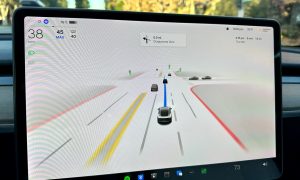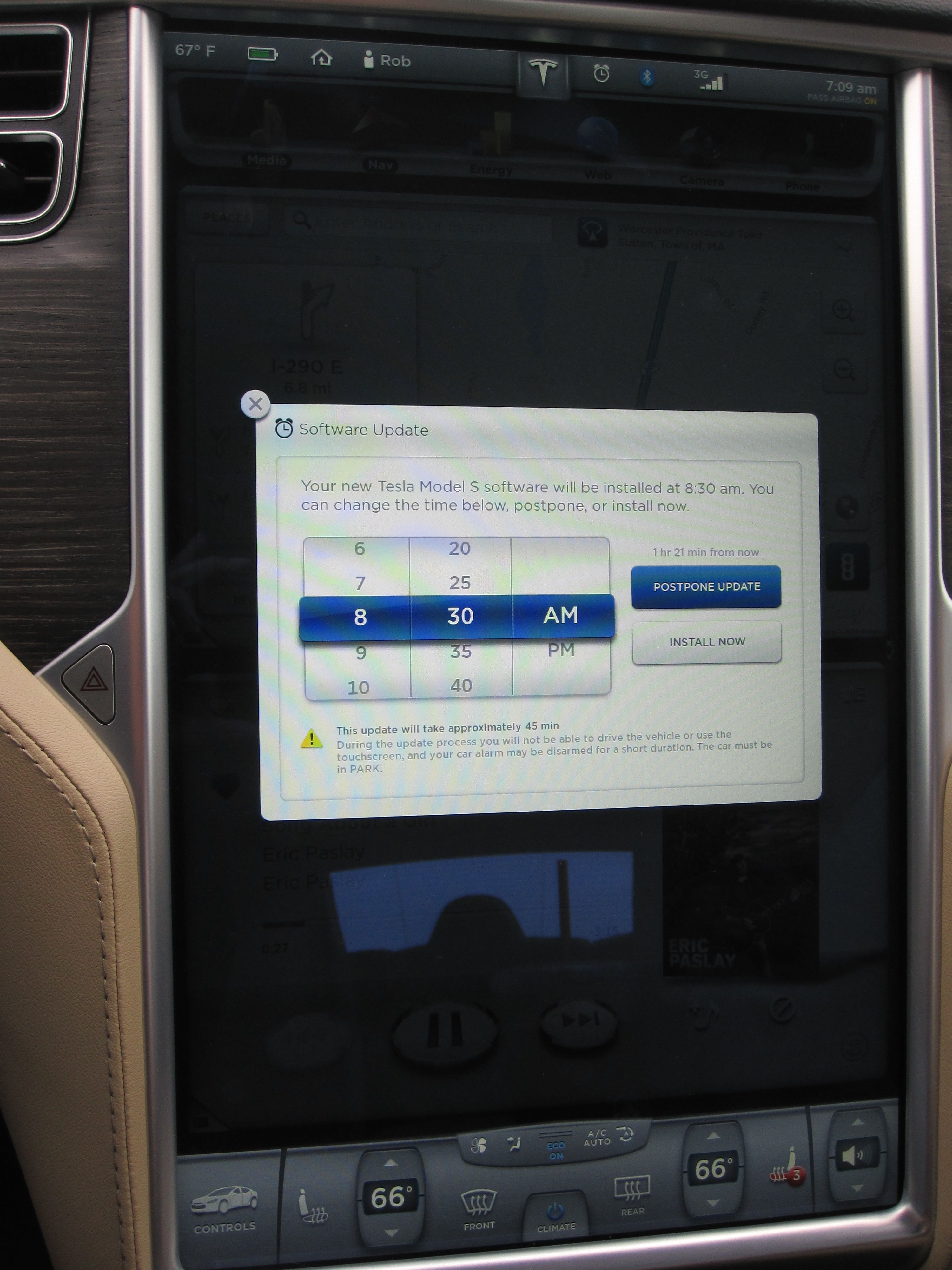

Firmware
How Does a Tesla Over-the-Air Software Update Work?
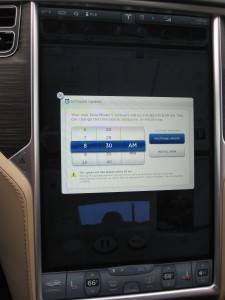 Perhaps only geeks appreciate this, but I was excited the other day to see a Tesla over-the-air software update notification pop up on my Model S. Software updates typically consist of minor fixes and tweaks but will sometimes include new and exciting functionality. Tesla is no different. In a past article, we took a look at Tesla’s frequency of software updates and their contents, but this post will focus on the actual update process.
Perhaps only geeks appreciate this, but I was excited the other day to see a Tesla over-the-air software update notification pop up on my Model S. Software updates typically consist of minor fixes and tweaks but will sometimes include new and exciting functionality. Tesla is no different. In a past article, we took a look at Tesla’s frequency of software updates and their contents, but this post will focus on the actual update process.
Tesla Over-the-Air Software Notification
An icon on the center touchscreen appears a new software update becomes available. Other than indicating availability of the software update, it doesn’t provide any details on what the update is about until after the installation.
Not everyone gets notified of an available update at the same time. However there are rumors that those with wifi connections tend to get updates faster than those relying only on a 3G connection.
If you dismiss the notification you can make it reappear by pressing the Tesla logo at the top center of the 17″ touchscreen. Otherwise you can start the install or schedule it to auto install at a later time.
Scheduling
![]() The car must be in park mode for the update to get applied which can take upwards of 45 minutes to install.
The car must be in park mode for the update to get applied which can take upwards of 45 minutes to install.
This was my first time experiencing a Tesla over-the-air software update so I decided to schedule the install 5 minutes in the future so I can watch the entire process.
Once scheduled, a new clock icon appears at the top of the 17″ screen. Clicking on it brings you back to the scheduling options for the software update but otherwise it will just remind you that scheduling has already taken place.
Updating
 A countdown notifies you that the Model S is about to install a software update. The ability to cancel the update is present, but once you run out of the countdown, the update will begin. And that’s about it for up to 45 minutes.
A countdown notifies you that the Model S is about to install a software update. The ability to cancel the update is present, but once you run out of the countdown, the update will begin. And that’s about it for up to 45 minutes.
Most people would walk away at this point, but the engineer in me couldn’t do that so I sat in the car for the entire update.
Your Model S will likely do things you didn’t know it could do. It’s going to make sounds, flash lights, spin fans, gurgle and do all sorts of other scary things. By the way, did you know your glove box button is lit?
There are a lot of components in a Model S. According to TeslaTap, there are 432 lights, 50 motors/solenoids, 52 processors and a host of other complex machinery in the Model S. Each component is controlled through software and thus paired with a test program.
The whole experience was kind of disturbing and I’m not sure I’d sit through another. At one point in the process the dash read this:
Although I was thinking “Uh oh, I bricked my $100K car!” Rather than hopping on the phone with Tesla, I waited it out. After 22 minutes of more frightening behavior including lost temperature readings, mismatched clocks on dash vs 17″ display, the sound of brakes tightening, and other exciting things, the touchscreen told me the update was successful.
Result
I lived through the Tesla over-the-air software update. I had previously been on version 5.9 (1.51.94) and was expecting to see version 5.11 but was disappointed to see the same 5.9 release notes when the update completed. Same minor release as before but just a few builds later.
I have no idea what Tesla did to my car since the release notes were identical between what I had and what I just got. I can’t say that I’ve noticed anything different since the update but I assume something was fixed or improved. I make sure my Model S is on wifi at all times (whenever possible) just to ensure I don’t miss my chance at getting an early Tesla over-the-air software update!
Firmware
Tesla mobile app shows signs of upcoming FSD subscriptions
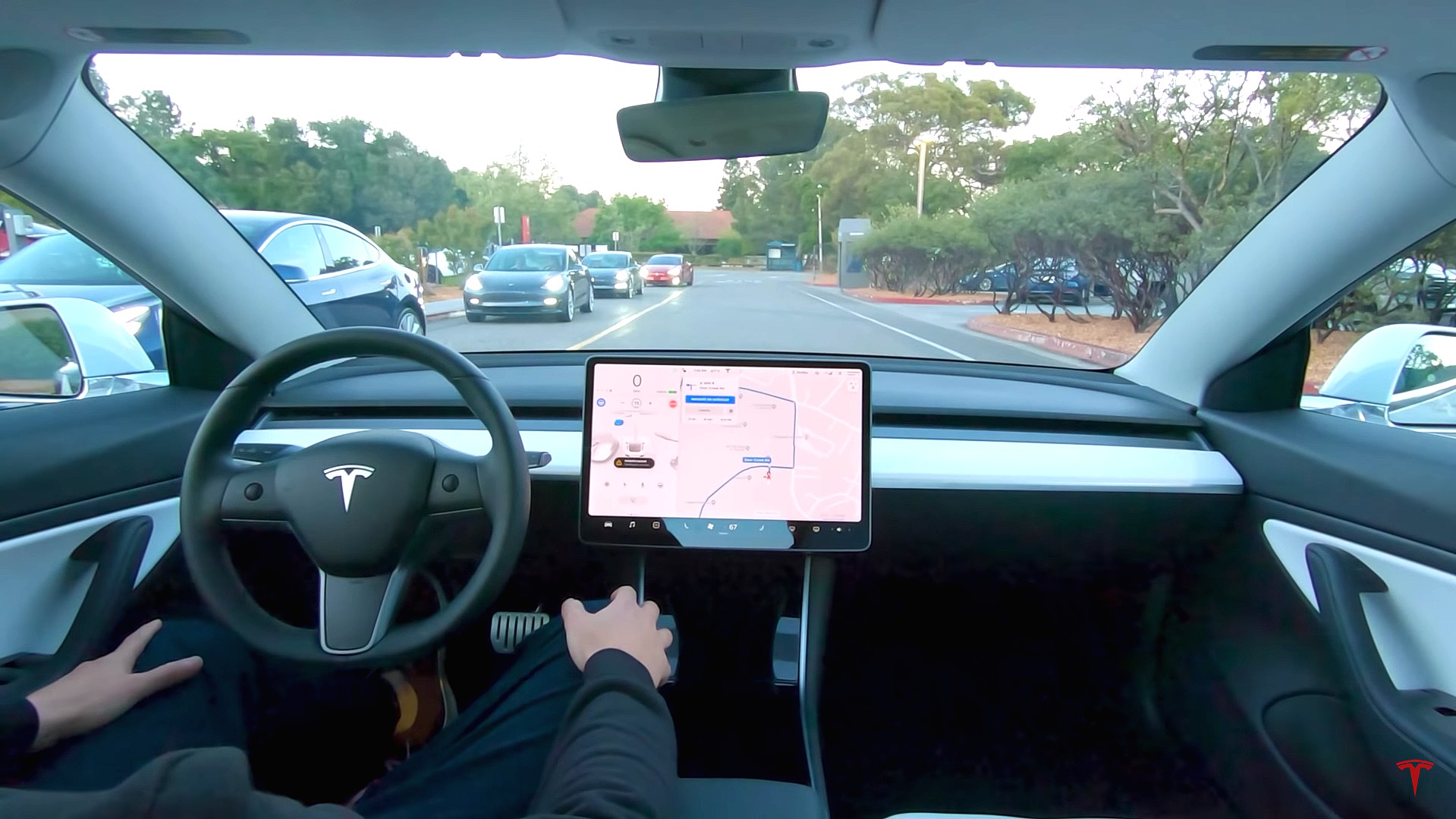
It appears that Tesla may be preparing to roll out some subscription-based services soon. Based on the observations of a Wales-based Model 3 owner who performed some reverse-engineering on the Tesla mobile app, it seems that the electric car maker has added a new “Subscribe” option beside the “Buy” option within the “Upgrades” tab, at least behind the scenes.
A screenshot of the new option was posted in the r/TeslaMotors subreddit, and while the Tesla owner in question, u/Callump01, admitted that the screenshot looks like something that could be easily fabricated, he did submit proof of his reverse-engineering to the community’s moderators. The moderators of the r/TeslaMotors subreddit confirmed the legitimacy of the Model 3 owner’s work, further suggesting that subscription options may indeed be coming to Tesla owners soon.
Did some reverse engineering on the app and Tesla looks to be preparing for subscriptions? from r/teslamotors
Tesla’s Full Self-Driving suite has been heavily speculated to be offered as a subscription option, similar to the company’s Premium Connectivity feature. And back in April, noted Tesla hacker @greentheonly stated that the company’s vehicles already had the source codes for a pay-as-you-go subscription model. The Tesla hacker suggested then that Tesla would likely release such a feature by the end of the year — something that Elon Musk also suggested in the first-quarter earnings call. “I think we will offer Full Self-Driving as a subscription service, but it will be probably towards the end of this year,” Musk stated.
While the signs for an upcoming FSD subscription option seem to be getting more and more prominent as the year approaches its final quarter, the details for such a feature are still quite slim. Pricing for FSD subscriptions, for example, have not been teased by Elon Musk yet, though he has stated on Twitter that purchasing the suite upfront would be more worth it in the long term. References to the feature in the vehicles’ source code, and now in the Tesla mobile app, also listed no references to pricing.
The idea of FSD subscriptions could prove quite popular among electric car owners, especially since it would allow budget-conscious customers to make the most out of the company’s driver-assist and self-driving systems without committing to the features’ full price. The current price of the Full Self-Driving suite is no joke, after all, being listed at $8,000 on top of a vehicle’s cost. By offering subscriptions to features like Navigate on Autopilot with automatic lane changes, owners could gain access to advanced functions only as they are needed.
Elon Musk, for his part, has explained that ultimately, he still believes that purchasing the Full Self-Driving suite outright provides the most value to customers, as it is an investment that would pay off in the future. “I should say, it will still make sense to buy FSD as an option as in our view, buying FSD is an investment in the future. And we are confident that it is an investment that will pay off to the consumer – to the benefit of the consumer.” Musk said.
Firmware
Tesla rolls out speed limit sign recognition and green traffic light alert in new update
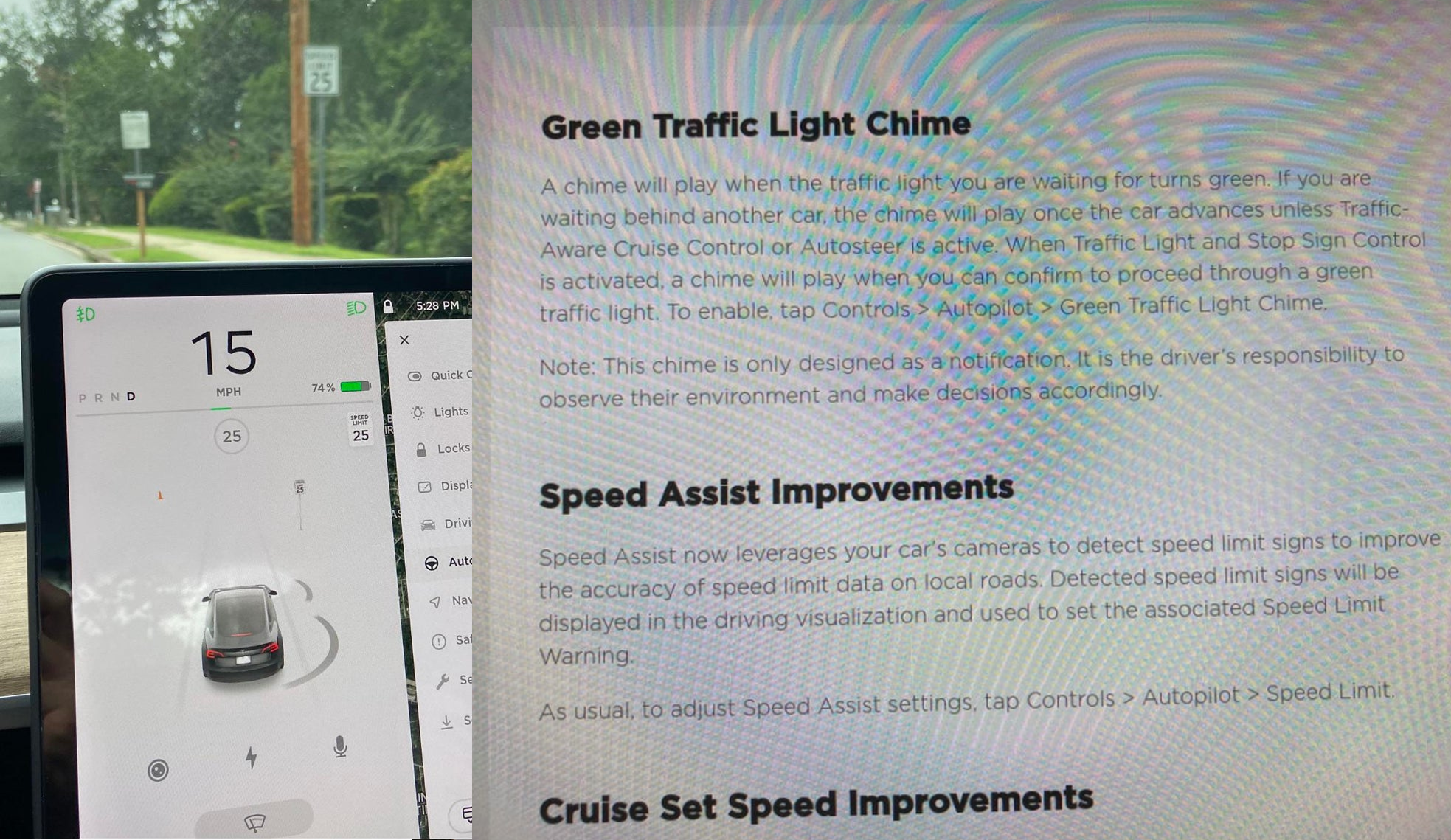
Tesla has started rolling out update 2020.36 this weekend, introducing a couple of notable new features for its vehicles. While there are only a few handful of vehicles that have reportedly received the update so far, 2020.36 makes it evident that the electric car maker has made some strides in its efforts to refine its driver-assist systems for inner-city driving.
Tesla is currently hard at work developing key features for its Full Self-Driving suite, which should allow vehicles to navigate through inner-city streets without driver input. Tesla’s FSD suite is still a work in progress, though the company has released the initial iterations of key features such Traffic Light and Stop Sign Control, which was introduced last April. Similar to the first release of Navigate on Autopilot, however, the capabilities of Traffic Light and Stop Sign Control were pretty basic during their initial rollout.
2020.36 Showing Speed Limit Signs in Visualization from r/teslamotors
With the release of update 2020.36, Tesla has rolled out some improvements that should allow its vehicles to handle traffic lights better. What’s more, the update also includes a particularly useful feature that enables better recognition of speed limit signs, which should make Autopilot’s speed adjustments better during use. Following are the Release Notes for these two new features.
Green Traffic Light Chime
“A chime will play when the traffic light you are waiting for turns green. If you are waiting behind another car, the chime will play once the car advances unless Traffic-Aware Cruise Control or Autosteer is active. When Traffic Light and Stop Sign Control is activated, a chime will play when you can confirm to proceed through a green traffic light. To enable, tap Controls > Autopilot > Green Traffic Light Chime.
“Note: This chime is only designed as a notification. It is the driver’s responsibility to observe their environment and make decisions accordingly.”
Speed Assist Improvements
“Speed Assist now leverages your car’s cameras to detect speed limit signs to improve the accuracy of speed limit data on local roads. Detected speed limit signs will be displayed in the driving visualization and used to set the associated Speed Limit Warning.
“As usual, to adjust Speed Assist settings, tap Controls > Autopilot > Speed Limit.”
Footage of the new green light chime in action via @NASA8500 on Twitter ✈️ from r/teslamotors
Amidst the rollout of 2020.36’s new features, speculations were abounding among Tesla community members that this update may include the first pieces of the company’s highly-anticipated Autopilot rewrite. Inasmuch as the idea is exciting, however, Tesla CEO Elon Musk has stated that this was not the case. While responding to a Tesla owner who asked if the Autopilot rewrite is in “shadow mode” in 2020.36, Musk responded “Not yet.”
Firmware
Tesla rolls out Sirius XM free three-month subscription
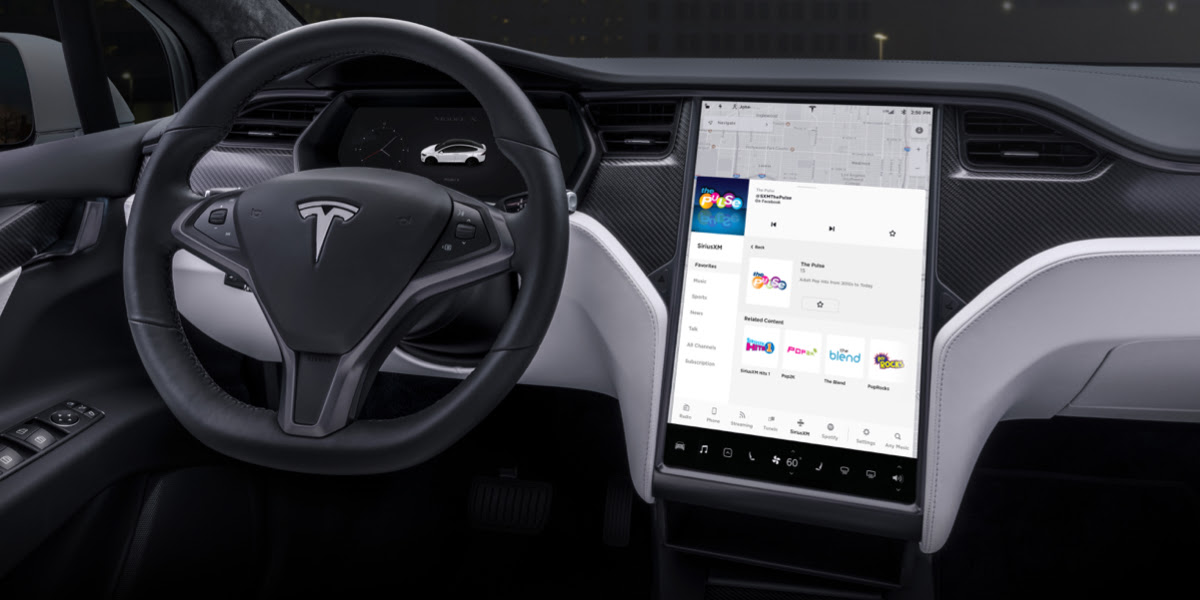
Tesla has rolled out a free three-month trial subscription to Sirius XM, in what appears to be the company’s latest push into making its vehicles’ entertainment systems more feature-rich. The new Sirius XM offer will likely be appreciated by owners of the company’s vehicles, especially considering that the service is among the most popular satellite radios in the country today.
Tesla announced its new offer in an email sent on Monday. An image that accompanied the communication also teased Tesla’s updated and optimized Sirius XM UI for its vehicles. Following is the email’s text.
“Beginning now, enjoy a free, All Access three-month trial subscription to Sirius XM, plus a completely new look and improved functionality. Our latest over-the-air software update includes significant improvements to overall Sirius XM navigation, organization, and search features, including access to more than 150 satellite channels.
“To access simply tap the Sirius XM app from the ‘Music’ section of your in-car center touchscreen—or enjoy your subscription online, on your phone, or at home on connected devices. If you can’t hear SiriusXM channels in your car, select the Sirius XM ‘Subscription’ tab for instruction on how to refresh your audio.”
Tesla has actually been working on Sirius XM improvements for some time now. Back in June, for example, Tesla rolled out its 2020.24.6.4 update, and it included some optimizations to its Model S and Model X’s Sirius XM interface. As noted by noted Tesla owner and hacker @greentheonly, the source code of this update revealed that the Sirius XM optimizations were also intended to be released to other areas such as Canada.
Interestingly enough, Sirius XM is a popular feature that has been exclusive to the Model S and X. Tesla’s most popular vehicle to date, the Model 3, is yet to receive the feature. One could only hope that Sirius XM integration to the Model 3 may eventually be included in the future. Such an update would most definitely be appreciated by the EV community, especially since some Model 3 owners have resorted to using their smartphones or third-party solutions to gain access to the satellite radio service.
The fact that Tesla seems to be pushing Sirius XM rather assertively to its customers seems to suggest that the company may be poised to roll out more entertainment-based apps in the coming months. Apps such as Sirius XM, Spotify, Netflix, and YouTube, may seem quite minor when compared to key functions like Autopilot, after all, but they do help round out the ownership experience of Tesla owners. In a way, Sirius XM does make sense for Tesla’s next-generation of vehicles, especially the Cybertruck and the Semi, both of which would likely be driven in areas that lack LTE connectivity.
-

 News2 weeks ago
News2 weeks agoTesla celebrates key milestone for 4680 battery cell production cost
-
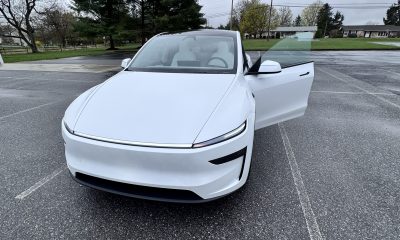
 News2 weeks ago
News2 weeks agoI took a Tesla new Model Y Demo Drive – Here’s what I learned
-
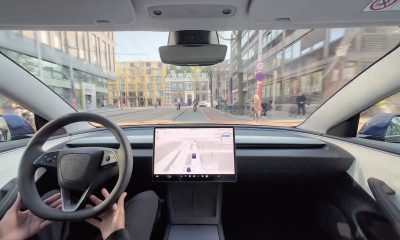
 News2 weeks ago
News2 weeks agoTesla Europe shares FSD test video weeks ahead of launch target
-
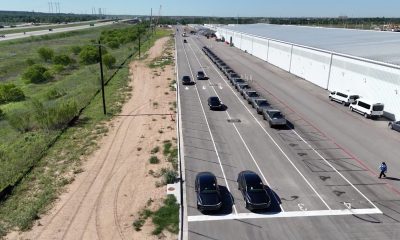
 News2 weeks ago
News2 weeks agoTesla’s Giga Texas vehicles now drive themselves to outbound lot
-
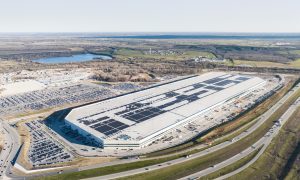
 News2 weeks ago
News2 weeks agoTesla’s ecological paradise near Giga Texas takes shape
-

 News2 weeks ago
News2 weeks agoElon Musk and top Trump trade advisor Peter Navarro lock horns over tariffs
-

 News2 weeks ago
News2 weeks agoTesla bull lowers price target citing ‘brand crisis’
-

 News2 weeks ago
News2 weeks agoTesla adding new safety features for improved emergency detection












